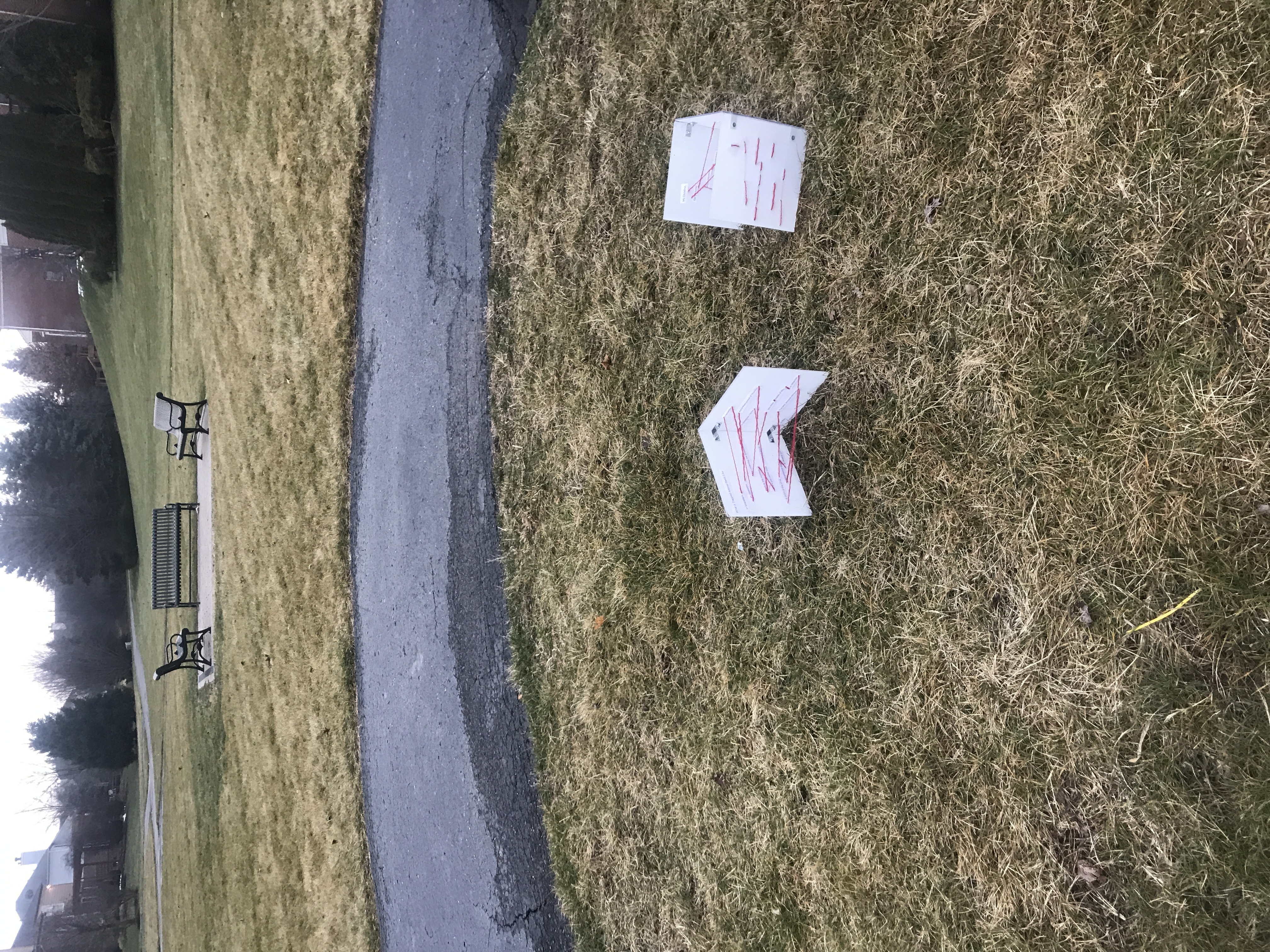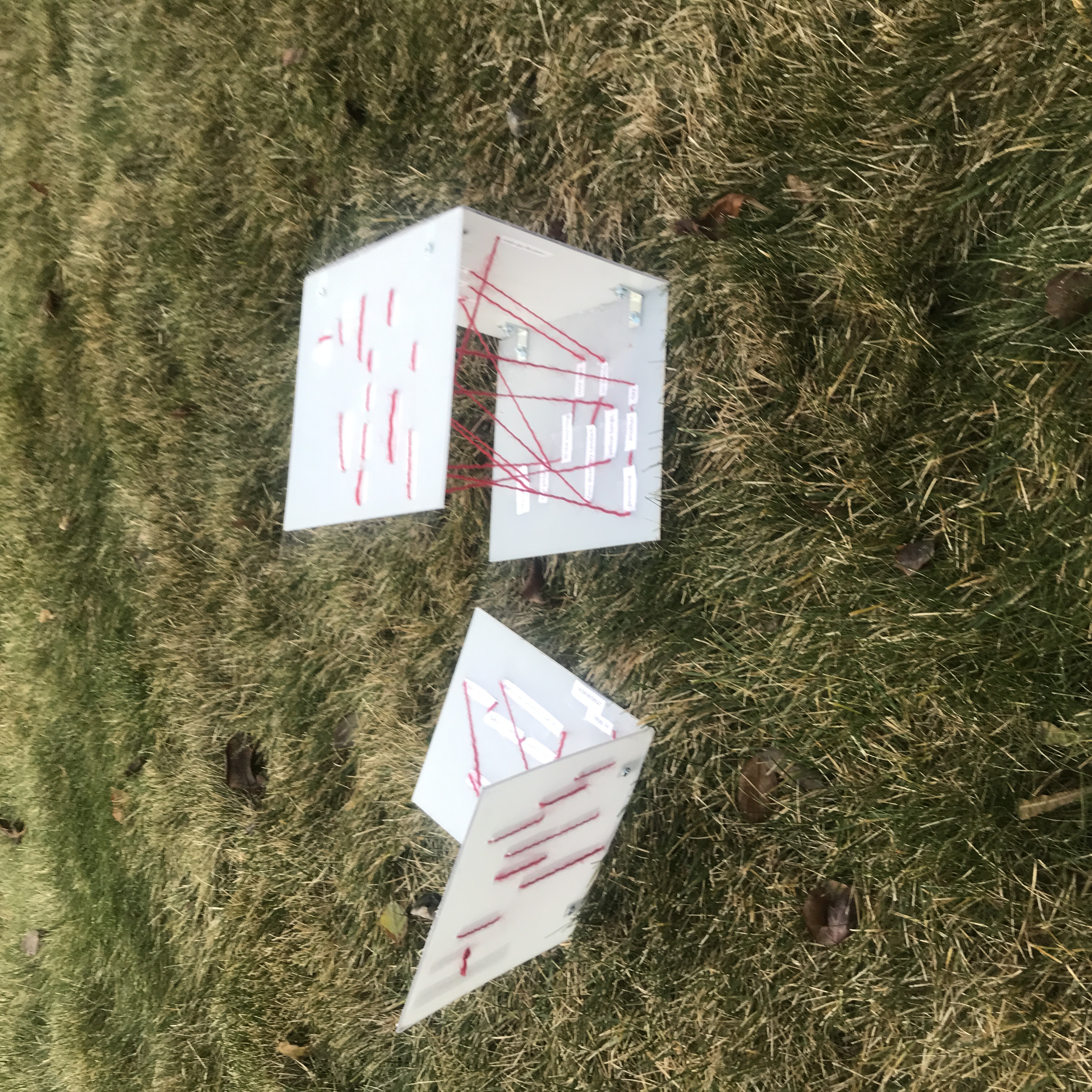Scroll ->
A Poetry Installation by Annie Fu
for Dr. J. Phillips Brown, ENGL 4982
Inspired by the recurring themes of contrasting materiality of poems and the depiction of tension in multimedia poetry this semester, I picked two of my favorite poems I drafted this semester and constructed an interactive installation. The installation took place in my neighborhood park in Michigan on Sunday, December 20th, 2020, and lasted from 3:40-5:50pm.
Working on this installation helped me think more deeply about the poems involved, and even led to further revision during the fabrication process. Through this project, I gained a new appreciation for physical prototyping as a potential revision exercise for poems. In the future, if I’m not sure how I want to proceed with revising a poem I’m not quite happy with, I might just challenge myself to sketch out and plan how I would present it to the public. For this piece, I was quite surprised at how naturally the idea for presentation came about, and although my installation for this course brought to fruition only one of the three original sets of sketches I made, I’m looking forward to building and installing the other two in the future.
A photo of the final view of the installation, with the two forms sitting, conversing with each other, in a vast field.
In the sketching and ideation phase, I drew out three different connected installations, to be placed in related but separate locations. The first two were to occur in a grassy public area, with the third in a type of more formal gallery space.
Materials, timeframe, and availability of public indoor spaces were limited due to the pandemic and the time of year, so I narrowed down this project to the set of forms in #1, since I had poems that directly fit the subject matter and tone of these structures.
The original sketches for the three components of the installation. For the scope of this project, I focused on number 1.
Keywords: playful, welcoming, clean
Keywords: combative, rigid, cautionary
Keywords: cold, reserved, balanced
I chose these materials carefully, with the awareness that the materials would affect the overall tone of the work, especially when viewed from a distance. One challenge in particular was in finding the right plexiglass for the feeling I wanted to evoke, which was an unsettling but unaggressive, yet vibrant structure that invited curiosity from people of all ages. In order to do this, I left the matte protective coating on the plexiglass rather than making it entirely clear.
Materials
Two pretty creepy, evocative photos of the yarn, showing its tendency to fray and have a "bleeding" appearance, and its varying thickness as well.
The handspun yarn also varies more in thickness along the strand, with some parts bunching up to be thicker mounds but other parts being really thin. All together, I felt the string evoked imagery of heartstrings, tendons, and other really fleshy, lively elements, while the plexiglass was assembled with steel L-brackets and was smooth, cold, and unlifelike.
One challenge in particular was finding the right plexiglass for the feeling I wanted to evoke, which was an unaggressive yet vibrant structure that invited curiosity from people of all ages. In order to do this, I left the matte protective coating on the plexiglass rather than making it entirely clear.
The cool, matte plexiglass with the red yarn were intended to have contrasting temperatures and textures, and the fact that the yarn was handspun emphasized this, as it frayed more easily and emitted small fibers in a sort of aura around the actual strand. However, one tradeoff to this fraying/looseness was that the taping process for the poem words often got small fibers trapped under the tape.
Fabrication
When I first started building out the forms, I realized my previous approach to creating multimedia poetry with strings by taping the strings down alongside the words could not work now, since the yarn shed so many fibers. Each time the tape was misplaced, I had to reprint the poem for a fresh copy to tape down.
I solved the issue by resorting to drilling holes for the yarn, and overall this improved my design because the resulting look, as seen on the right, is evocative of stitches in the side of the plexiglass. Contrasting the smoothness with these bright lines of sinewy red connected really nicely to themes in my poem.
Left: an intermediate stage of fabrication, where I'm in the middle of threading the yarn through drilled holes.
Top Right: Tying the knot to finish off the first piece.
Bottom Right: How the second piece looked before the holes were drilled and yarn was inserted.
I was really happy with the final appearance of the two forms--the strings pulled taut between the different panels and evoked tension in the exact way I intended, but when set on its side, the first structure also dropped in tension and featured slack strings as well. With this in mind, the intention for the visitors to the installation was to have them toss, rotate, or roll the structures and see how the strings changed tension.
The final design I built out involved five sheets of a matte plexiglass cut into 8 by 8 squares. From those I used L brackets to construct two structures, one in an L shape with two sheets attached on an edge, and the other in a C shape with three sheets attached on two edges. The poems, split into two and three portions respectively, were then pasted on the inside of the partial cubic forms and connected to be read in order with red handspun yarn.
Left: An overview of the the two structures.
Bottom: How the strings look when pulled taut.
Right: An example of the strings falling slack when placed on the side
Sketching + Ideation
Scroll v
Installation
When I set out to install the work in public, I didn’t get as lucky as I had hoped. The past week in my hometown in Michigan has been at or below freezing, so my chosen venue, a neighborhood park with multiple walking trails in and around it, showed very few visitors during the two hours I was there.
The installation site was in plain view from most corners of the open field, and due to its proximity to a pavilion of benches and jungle gyms, I hoped some people out for their afternoon or early evening walk might stop by the park and see the structures on their way in. This didn’t happen though--I saw two little girls walk a dog, one runner who didn’t slow down at all, AND a biker in the distance on the path perpendicular to mine. I think with a combination of living in a suburban neighborhood, the coldness of the outdoors, and the pandemic, the foot traffic is low on any given day.

When the work was installed, I took note of the contrasts between my idealized version of the installation, with the bright white forms sitting in lush green grass and contrasting with the red string and people walking by with families to be around the installation or maybe interact with it, and the reality. The cubes were meant to invite touching or even throwing or rolling, since the content of the poem touches on themes of youth and parenthood and the contrast between playful and violent experiences.
To not see that happen felt like a large part of the installation’s intention was lost. I was wondering if by choosing a form with the motivation of inviting contact, and by not having those interactions happen, if I compromised the ability for the poem to stand on its own as a work. The original text held more of an independent meaning and didn’t need to fulfil a quota in my mind to express its meaning, but the installation did, and I ended up appreciated that the prospect of putting the poem into a public space with a more physical form came with a separate set of expectations for how it would be received.
If I were to install this piece again, I would choose a similarly public space, but choose a warmer time of year to put it up. The piece is already cold to the touch with the plexiglass, so having it sit alone in a frozen field in the middle of winter was a little harrowing to see. Ideally, a warmer spring or summer day would better align the intended audience with the installation.



Thank you for viewing!
I'm always open to feedback, so if you have any thoughts on this piece,
feel free to reach out at af397@cornell.edu!
<--Scroll